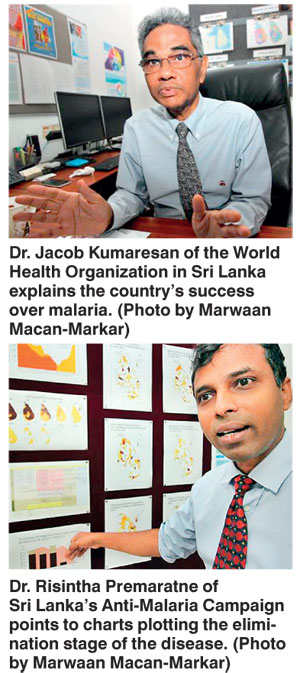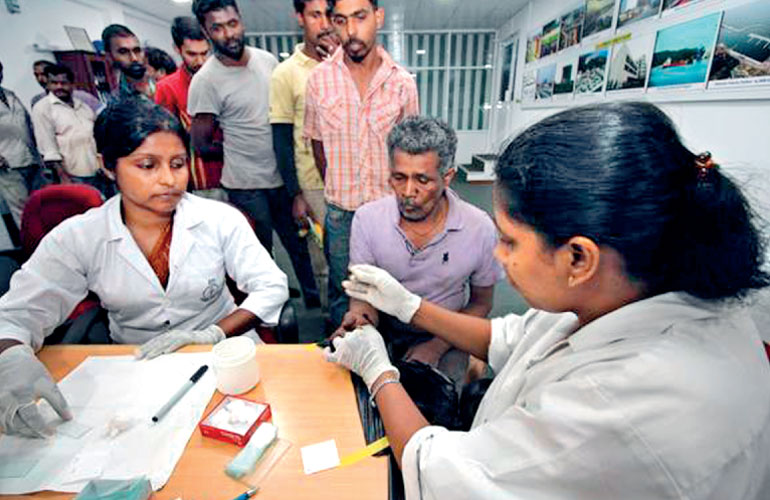Tuesday Mar 11, 2025
Tuesday Mar 11, 2025
Tuesday, 4 October 2016 00:05 - - {{hitsCtrl.values.hits}}
By Marwaan Macan-Markar, Asia Regional Correspondent
asia.nikkei.com: On a weekday afternoon, a public health team attached to a mobile malaria clinic makes its way in a vehicle down a narrow street in Ekala, a congested factory town of light and heavy industry north of Colombo, the Sri Lankan capital. The four-member team spends over two hours at one site, a cavernous, noisy steel-bar production plant, to test some Indian and local workers for malaria. During that time, Dinithi Wijesekera, a laboratory specialist, draws blood from the middle fingers of 117 sweat- soaked men as part of the clinic’s rapid diagnostic tests. No one tests positive for the parasite.
soaked men as part of the clinic’s rapid diagnostic tests. No one tests positive for the parasite.
It is another bit of good news at the Colombo headquarters of the South Asian nation’s anti-malaria campaign (AMC). The State-run organisation deploys mobile teams throughout the country to track any signs of “imported malaria,” a term for the disease from a patient carrying a foreign parasite transmitted by a malaria-bearing mosquito during international travel, or for a foreign worker who arrives in Sri Lanka from such malaria belts. Since the beginning of this year, the AMC’s teams have identified and isolated 32 “imported malaria” cases for treatment. In 2015, there were 36 such cases, 49 in 2014, and 95 in 2013.
The surveillance is aimed at preserving Sri Lanka’s impressive feat: eliminating the indigenous malaria parasite for the past three years, with no local cases reported since November 2012. In early September, the World Health Organization declared the country malaria-free, a milestone for a tropical country with a population of its size, nearly 21 million. It is only the third in the South and East Asia regions to reach that goal, with the other two, Singapore and the Maldives, having smaller populations and lesser terrain. In May, the WHO also declared Sri Lanka free of lymphatic filariasis, another mosquito-borne disease that disfigures the legs of patients.
Sri Lanka’s progression to this milestone was hardly smooth. It was set against a backdrop of a bloody 30-year civil war, where access to areas controlled by the Tamil Tiger rebels was limited. But the rebels did not boost the anti-malaria efforts in the same way they had, on occasions, announced limited ceasefires to permit polio immunisation. The anti-malaria campaign was also conducted with limited resources, since the Government spends only 1.5% of gross domestic product on health.
That is what makes Sri Lanka’s achievements “memorable,” Jacob Kumaresan, the WHO’s representative in Sri Lanka, told the Nikkei Asian Review. “Sri Lanka maintained focus and struggled through the period of the conflict to eliminate malaria, and its other lesson was it achieved its goal without the resources of a developed country,” he noted.
Even so, Sri Lanka’s drive against malaria has a long history, dating back to 1911 when the country, under British colonial rule, launched its first anti-malaria campaign. During the first half of the 20th century, it was one of the most malaria-affected countries in Asia. Its worst epidemic was over a seven-month stretch toward the end of 1934, when malaria infected over 1.5 million people and killed over 80,000 patients, nearly 1.5% of the island’s population of 6 million people.
This is not the first time the country is earning its place as a model in the global campaign against malaria, which had infected 214 million people worldwide and accounted for 438,000 deaths in 2015, with Africa the worst affected. The WHO’s World Malaria Report 2015 warns of 1.3 billion people in South and East Asia at risk of the killer disease.
The last time Sri Lanka was regarded as a model was in the 1960s, more as a measure of failure than a winner. It followed the achievements in 1963, when Sri Lanka had brought the annual number of malaria cases down to only 17, the result of spraying DDT insecticide to control the mosquito population. But it let its guard down, and the disease had “roared back” by 1969, with cases soaring to over 500,000. By 1999, malaria cases stood at 246,549 for the year.
The latest success marks a shift in combatting the disease, with public health policymakers promoting parasite control as the route to eliminating the Anophelese mosquito-borne parasite than limiting the battle against malaria to only vector control. Through the campaign launched in 1999, they placed faith in mobile malaria clinics and rapid deployment teams.
Tapping the country’s extensive free health care network – under which any patient is entitled to medical treatment within a 3km-radius – the teams worked around the clock, developing patient databases for early detection, and involving local communities, to isolate any patient to prevent the parasite from spreading. Prompt treatment and continued monitoring and care followed, recounted a Health Ministry official.
 Dinithi Wijesekera of a malaria mobile clinic draws blood from a worker in a steel plant in Ekala. (Photo by Marwaan Macan-Markar)
Dinithi Wijesekera of a malaria mobile clinic draws blood from a worker in a steel plant in Ekala. (Photo by Marwaan Macan-Markar)
This expansion, drawing on a force of 3,000 health workers to fan out as rapid response teams, made up for the limits of vector control, which included spraying insecticide, and providing insecticide-treated bed nets in suspected malaria pockets in remote corners. The mobile clinics were able to trace “hidden parasite reservoirs” in people who had been treated, said Lalanthika Peiris, a 30-year public-health veteran in battling malaria in the Southern Province. “We went to each and every village where cases were reported to detect, treat and follow-up.”
By 2001, the results of the new strategy were encouraging, as malaria cases marked a steep drop to 66,552 cases for the year, a 68% reduction from the nearly 250,000 cases two years before. “That was such a motivational factor for our struggle against malaria,” said Risintha Premaratne, former Director of Sri Lanka’s Anti-Malaria Campaign. “What we were doing was eliminating malaria by not eliminating the mosquito.”
The earlier years of the campaign laid the foundation for Sri Lanka to adopt an ambitious goal: elimination. That announcement in 2008, when the number of malaria cases had dropped to 1,000 a year, shifted attention to the battlefront in the country’s north and northeastern regions. There, Government troops and the Tamil Tiger separatists were locked in bloody conflict in the remaining pockets of malaria-infested arid forests. It is hardly surprising that it was in Mullaitivu, where Government troops defeated the separatists to end the war in May 2009, that Sri Lanka’s last indigenous malaria parasite case was detected. That was a 30-year-old soldier in an Army camp on 23 October 2012. After that, the clock started ticking for the country to receive its WHO accolade as malaria-free.
“It is a different ball game now after elimination, because our surveillance has to be top notch to maintain our achievement,” said Premaratne, an architect of Sri Lanka’s success over malaria. “We go to the place of patients at midnight even to detect and eliminate the imported parasite.”
At a time when the global spread of the Zika virus and other mosquito-borne diseases has left a trail of unease among international travellers, Sri Lanka has at least gained a reason to boast. At Colombo’s international airport, the writing is on the wall. A colourful poster states: “Welcome to Malaria free Sri Lanka.” From that viewpoint, 100 years of healthcare has well and truly paid off.
(Source: http://asia.nikkei.com/Politics-Economy/Economy/Sri-Lanka-s-malaria-milestone?page=1)
Discover Kapruka, the leading online shopping platform in Sri Lanka, where you can conveniently send Gifts and Flowers to your loved ones for any event including Valentine ’s Day. Explore a wide range of popular Shopping Categories on Kapruka, including Toys, Groceries, Electronics, Birthday Cakes, Fruits, Chocolates, Flower Bouquets, Clothing, Watches, Lingerie, Gift Sets and Jewellery. Also if you’re interested in selling with Kapruka, Partner Central by Kapruka is the best solution to start with. Moreover, through Kapruka Global Shop, you can also enjoy the convenience of purchasing products from renowned platforms like Amazon and eBay and have them delivered to Sri Lanka.
Discover Kapruka, the leading online shopping platform in Sri Lanka, where you can conveniently send Gifts and Flowers to your loved ones for any event including Valentine ’s Day. Explore a wide range of popular Shopping Categories on Kapruka, including Toys, Groceries, Electronics, Birthday Cakes, Fruits, Chocolates, Flower Bouquets, Clothing, Watches, Lingerie, Gift Sets and Jewellery. Also if you’re interested in selling with Kapruka, Partner Central by Kapruka is the best solution to start with. Moreover, through Kapruka Global Shop, you can also enjoy the convenience of purchasing products from renowned platforms like Amazon and eBay and have them delivered to Sri Lanka.